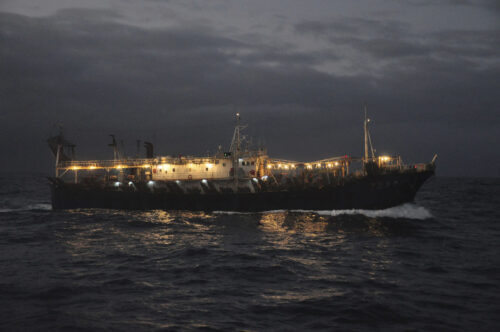Usually when you want to protect something, you have to know where it is. That sounds like common sense, but when it comes to protecting highly migratory species in the oceans, scientists, conservationists and resource managers are often flying blind. Marine animals such as sharks, turtles, whales and large mid-ocean fish like tuna often traverse thousands of miles of ocean every year making them hard to keep an eye on.
Over the last decade, technological advances in remote tracking devices are steadily opening our eyes to the lifestyles and habits of some of these migratory species. The view is enlightening. Two recent studies provided unexpected details about the private lives of five types of sharks.
One study revealed an overlap between fishing activity and roughly 80 percent of the range for blue and mako sharks, two heavily fished species. Meanwhile another study found that between zero and 35 percent of the core habitat range for great hammerhead, bull, and tiger sharks is protected despite being in mostly US waters.
As early as the 1980s scientists were using miniaturized devices to remotely track marine animals by satellite. Some of the earliest groundbreaking research followed a single basking shark for 17 days via UHF radio transmitter. That early device trailed behind the animal on a 10-meter tow wire attached to its fin in order to ensure transmission from the antenna when the fish surfaced. It was bulky and limited in the amount and type of data it could collect.
In the decades since, tremendous improvements in miniaturization, battery power and satellite coverage have enabled scientists to track migratory animals over vast areas of the ocean for months and years at time while gathering information not only on where they go, but on animal physiology and the environment around them. The scientific literature is now rife with tracking data from thousands of marine animals around the world. Researchers are methodically piecing together their stories. They are stories that intersect with ours far more frequently than necessary, and they often end poorly for the animals.
Some of our largest ocean predators have been depleted by overfishing and accidental entrapment in fishing gear, and many more species remain vulnerable to the same fate. According to the International Union for Conservation of Nature (IUCN) red list, great hammerheads frequently hauled in as bycatch are now endangered. Mako sharks are vulnerable to extinction, and tiger sharks are near threatened. The list goes on. And yet, shark fishing remains largely unregulated, especially for oceanic species.
Neil Hammerschlag, a co-author of both recent shark tracking studies, hopes that understanding where these large and important predators are most vulnerable to fishing will encourage and enable conservation efforts. “By using telemetry for tracking these apex species, we are able to provide policy makers with the data they need to protect them,” he says. A research assistant professor and director of the Shark Research & Conservation Program at the University of Miami, Hammerschlag has been tagging sharks for 15 years, and using satellite technology to track them for the last six years.
He is part of an international team of researchers that spent four years tracking 96 satellite-tagged sharks and 186 longline fishing vessels from Spain and Portugal operating in the North Atlantic. They found an alarming overlap in which the vessels fished heavily throughout the same habitat range used by blue and mako sharks. Some individual sharks spent more than 60 percent of their time in close proximity to longliners. The researchers determined that blues and makos were at risk of being caught 20 and 12 days per month respectively.
The take-home message of that study, according to Hammerschlag is that these species are at high risk of being overfished, and to prevent them from being depleted, conservation measures such as international quotas or size limits should be considered. He says tracking the activity of both fishing vessels and fish should be an important part of establishing ocean-wide management strategies.
In a second study, Hammershlag and another team of colleagues tagged and tracked 86 sharks (bull, great hammerhead and tiger sharks) in waters off south Florida and the northern Bahamas. They were interested in identifying core habitat use areas where the sharks spend most of their time and hotspots that are critical for mating, giving birth and feeding. By comparing these areas with zones in which sharks are protected or fishing is prohibited, they found that only a fraction of these waters are protected (18 percent for great hammerheads and 35 percent for tigers). It’s particularly troubling that the great hammerhead is endangered. What’s more, none of the bull shark’s core habitat is protected.
Perhaps it is encouraging, however, that Hammerschlag and his colleagues also discovered the majority of the core habitat use areas for all three of these sharks falls within the US Exclusive Economic Zone. “Tiger sharks are already protected in the Bahamas,” Hammerschlag says, “but they don’t stay there, they move as do all of these large migratory species. And it turns out that the majority of their core habitat use area is not in the Bahamas, but within US waters.” With enough will and commitment, fisheries managers can help ensure the safety of these vulnerable species.
The results of both studies were surprising to the researchers, and although the news was not necessarily good, it offers a path to improving the welfare of these five species of shark. With the knowledge that comes from this type of research, the story of large pelagic fish may have a chance at a happy ending.
You can see the tracks of individual sharks on Google Maps on Hammerschlag’s shark tracking site here: http://sharkresearch.rsmas.miami.edu/education/virtual-learning/tracking-sharks
This year, Oceana has provided 20 new telemetry tags for Hammerschalg’s continued research. In a previous post, Tracking Fish and Ships, we describe the collaborative efforts with Wessley Merten, Oceana’s data and fisheries analyst for Global Fishing Watch.


